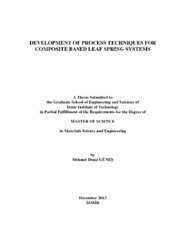Please use this identifier to cite or link to this item:
https://hdl.handle.net/11147/3677Full metadata record
| DC Field | Value | Language |
|---|---|---|
| dc.contributor.advisor | Tanoğlu, Metin | - |
| dc.contributor.author | Güneş, Mehmet Deniz | - |
| dc.date.accessioned | 2014-07-22T13:52:08Z | - |
| dc.date.available | 2014-07-22T13:52:08Z | - |
| dc.date.issued | 2013 | - |
| dc.identifier.uri | http://hdl.handle.net/11147/3677 | - |
| dc.description | Thesis (Master)--Izmir Institute of Technology, Materials Science and Engineering, Izmir, 2013 | en_US |
| dc.description | Includes bibliographical references (laves: 67-68) | en_US |
| dc.description | Text in English; Abstract: Turkish and English | en_US |
| dc.description | xi, 68 leaves | en_US |
| dc.description | Full text release delayed at author's request until 2017.01.15 | en_US |
| dc.description.abstract | Fiber reinforced composites have been utilized in automotive industry due to their superior mechanical performance and lower density as compared to conventional metallic materials. Leaf spring systems are the important parts of the automobiles, which effects the weight of the vehicle in addition to driving performance and security. In this study, composite based leaf spring systems were developed, manufactured and characterized. Five different types of composite plates were manufactured with three different types of reinforcing material via resin transfer molding process and characterized in order to select the proper composite material for spring applications and design the composite leaf spring prototypes. Glass fiber reinforced epoxy, carbon fiber reinforced epoxy and glass/carbon hybrid fiber reinforced epoxy composite plates having unidirectional and [0o/90o] biaxial stacking sequences were fabricated. Tensile, flexural and thermo-mechanical properties of composite plates were determined within the study. Test results showed that unidirectional glass fiber reinforced epoxy composites are the most suitable materials for spring applications due to their higher strain energy capability as compared to carbon and hybrid fiber reinforced epoxy composites. Composite leaf spring prototypes were manufactured based on two geometrical design by resin transfer molding procedure. Three different types of leaf spring prototypes with various fiber configuration were manufactured based on the first geometrical design and characterized by mechanical rig test. Mechanical rig test results showed that composite leaf spring which contains 56 layers of glass fiber and 4 layers of carbon fiber has the most suitable fiber configuration for leaf spring designed based on first geometrical design. | en_US |
| dc.language.iso | en | en_US |
| dc.publisher | Izmir Institute of Technology | en_US |
| dc.rights | info:eu-repo/semantics/openAccess | en_US |
| dc.subject.lcsh | Composite materials in automobiles | en |
| dc.subject.lcsh | Leaf springs | en |
| dc.title | Development of Process Techniques for Composite Based Leaf Spring Systems | en_US |
| dc.type | Master Thesis | en_US |
| dc.institutionauthor | Güneş, Mehmet Deniz | - |
| dc.department | Thesis (Master)--İzmir Institute of Technology, Materials Science and Engineering | en_US |
| dc.relation.publicationcategory | Tez | en_US |
| dc.identifier.wosquality | N/A | - |
| dc.identifier.scopusquality | N/A | - |
| item.openairecristype | http://purl.org/coar/resource_type/c_18cf | - |
| item.openairetype | Master Thesis | - |
| item.languageiso639-1 | en | - |
| item.grantfulltext | open | - |
| item.fulltext | With Fulltext | - |
| item.cerifentitytype | Publications | - |
| Appears in Collections: | Master Degree / Yüksek Lisans Tezleri | |
Files in This Item:
| File | Description | Size | Format | |
|---|---|---|---|---|
| 10013576.pdf | MasterThesis | 4.03 MB | Adobe PDF |  View/Open |
CORE Recommender
Page view(s)
298
checked on Jun 16, 2025
Download(s)
498
checked on Jun 16, 2025
Google ScholarTM
Check
Items in GCRIS Repository are protected by copyright, with all rights reserved, unless otherwise indicated.